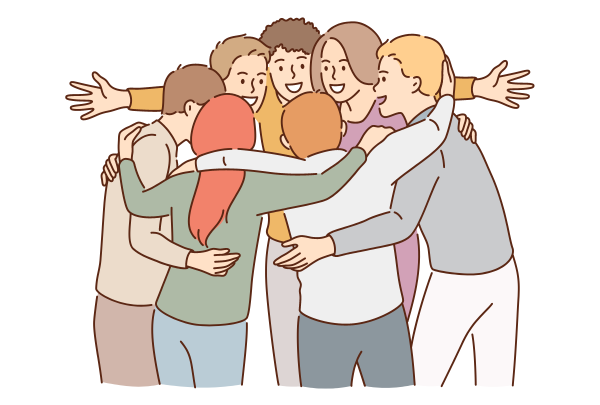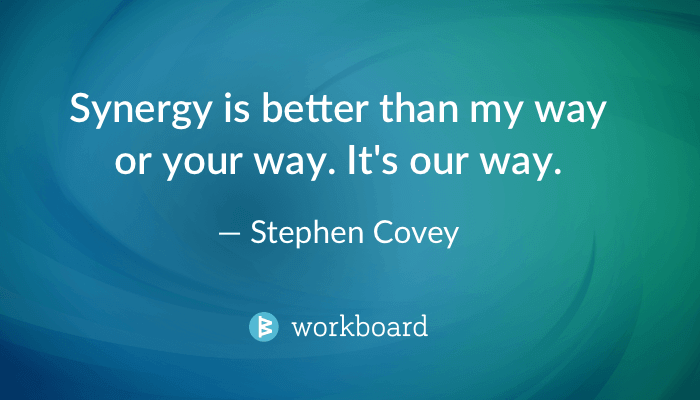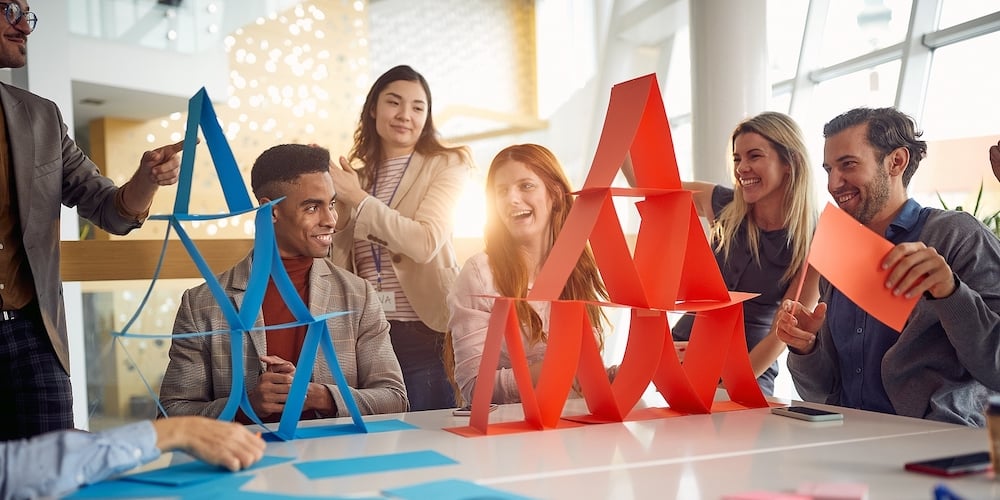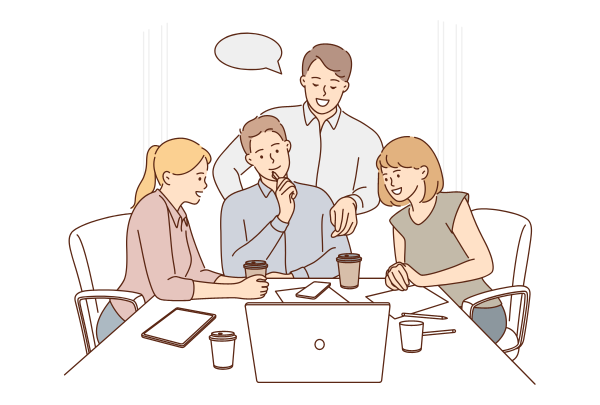Team Synergy: The Strength of the Team is Each Individual Member
By Team Lean Agile Intelligence

The Strength of the Team is Each Individual Member
The success of an organization hinges upon its ability to foster a culture of shared ownership and collaboration among its members, known as Team Synergy. Promoting collaboration in agile teams can result in increased productivity and effectiveness among team members.
In this post, we delve into the best practices of Team Synergy. By following foundational techniques at various stages of your learning journey, you can acquire strategies to implement within your team. However, it's important to note that Team Synergy is just one piece of the puzzle. To gain a holistic view of your team's current process status, take advantage of our free agile assessment for Team Agility.
Team Synergy and The Learning Journey
At Lean Agile Intelligence, we recognize Team Synergy as the sense of shared ownership and collaboration among team members. We divided the learning journey into 4 different stages: Developing, Emerging, Adapting, and Optimizing. In the following sections, we will discuss each stage in detail as well as provide practical tips and techniques to help you extend your skills in this area.

Source - How to Create Team Synergy and Keep It Going
Developing
A Team "developing" an understanding of the value of Synergy and adopting the foundational techniques should focus on the following improvements:
-
The What: The team has an identity (i.e., name)
-
The How: A team should establish an identity. Doing exercises such as creating team branding, developing team norms and values, and establishing a clear team purpose can greatly help. Check out 3 activities that a team can use to accomplish this:
-
"Namestorming" - This activity involves the team brainstorming and generating a list of potential team names, and then collectively discussing and selecting the most fitting name that reflects the team's identity, values, and goals.
-
"Motto Crafting" - This activity involves the team brainstorming and creating a team motto or slogan that captures the essence of their team's purpose, values, and aspirations, and serves as a memorable rallying cry for the team.
-
"Culture Creation" - This activity involves the team collaboratively defining their team culture, which includes the shared values, norms, behaviors, and attitudes that shape their team dynamics and interactions, and contribute to their overall success.
-
-
-
The What: The team has a shared understanding of the goals of the products/initiatives they are working on
-
The How: Defining a clear product vision and objectives help all team members create a shared understanding of the goals of what they are working on. Utilize SMART (Specific, Measurable, Achievable, Relevant, Time-bound) objectives to craft a product vision statement and regularly communicate this with the team. Another strategy is to conduct collaborative product discovery sessions with the team to explore and define the product or initiative requirements, features, and user stories. This can involve techniques such as user story mapping, product backlog refinement, and cross-functional workshops to gather inputs from team members, stakeholders, and end-users.
-
-
The What: The team has a common language they use to describe their work
-
The How: Having a common language to describe the work within the team ensure clear and effective communication. The team can define their own team-specific terminology by coming up with a team-specific glossary that includes key terms and acronyms that are commonly used within the team. The team could also adopt the agile framework-specific terminology, such as Scrum or Kanban, to ensure that all team members are familiar with the framework's specific terminology. This can include terms like backlog, sprint, user story, and other framework-specific concepts.
-
-
The What: The team has a collaborative workspace (on-site or remote) and utilizes collaboration tools for communication, sharing, and fun
-
The How: Extreme Programming (XP), an agile framework that predates the agile manifesto, emphasizes the practice of an "Informative workspace" which involves creating feedback mechanisms to support daily work. These mechanisms can include visual displays such as Information Radiators, manually updated by team members, or electronic devices like eXtreme Feedback Devices (XFD) such as lava lamps or audio signals linked to automated processes. It is crucial to ensure that these feedback mechanisms are easy to interpret, low maintenance, and tailored to local practices, as stated by Davies R Bacon.
- The How: In a collaborative in-person workspace, an informative workspace can be established by providing tools such as whiteboards, sticky notes, flip charts, markers, and other physical resources that facilitate communication, sharing, and collaboration. Team members can use these tools to visually represent information, track progress, and gather feedback in real-time, creating a collaborative and interactive environment.
- The How: When working remotely, replicating the collaborative nature of in-person tools can be achieved through various strategies. Utilizing online collaboration tools such as Miro, Mural, and other similar platforms can provide virtual workspaces where team members can collaborate in real-time. These platforms offer features such as digital whiteboards, sticky notes, and interactive diagrams that can be used for brainstorming, planning, and sharing information. It's also essential to create opportunities for team bonding and fun in a remote setting. Virtual team-building activities, social events, and informal channels for communication can foster team camaraderie and promote a collaborative culture, despite being physically apart.
-
Emerging
A Team "emerging" beyond the foundational techniques of Synergy and embracing it as they become more proficient should focus on the following improvements:
-
The What: Team members know what each other is working on and ensure open lines of communication, alignment of efforts, and management of dependencies
-
The How: Two things that the team can have in place for this is to have Daily Stand-up Meetings and Regular Check-Ins. Conducting Daily Stand-up Meetings help ensure that everyone is aware of each other's work and that any potential blockers or dependencies are addressed promptly. Having Regular Check-Ins, such as one-on-one meetings to discuss work, challenges, and progress helps build open lines of communication and address any potential bottlenecks or dependencies.
-
-
The What: The team listens to each other’s opinions and considers tradeoffs
-
The How: A good technique for teams to use is called the Five Whys, which is a technique used to identify the root cause of a problem or decision. The Five Whys technique encourages active listening and promotes a deeper understanding of each other's perspectives. By uncovering the root cause of a decision or issue, teams can identify potential tradeoffs and make more informed decisions. The number of "whys" may vary depending on the complexity of the decision or issue being discussed, and it's important for teams to be flexible and adapt the technique to their specific needs and context.
- Teams can use the Five Whys technique in a collaborative decision-making process by following these steps:
- Identify the decision or issue that needs to be resolved.
- Start with a question like "Why is this decision or issue important?"
- Keep asking "why" and drilling down to the root cause of the decision or issue.
- Record the answers to each "why" question to track the thought process.
- Repeat the process at least five times or until the team reaches a clear understanding of the underlying motivations or concerns.
- The number of "whys" may vary depending on the complexity of the decision or issue being discussed, and it's important for teams to be flexible and adapt the technique to their specific needs and context.
- Teams can use the Five Whys technique in a collaborative decision-making process by following these steps:
-
* * * * * *
"A team should establish an identity."
* * * * * *
Adapting
A Team "adapting" the behaviors that create Synergy, should focus on the following improvements:
- The What: All team members are willing to play any role needed to get things done, even if it means taking on a task outside of their functional area
-
The How: Communicating the "Big Picture" can help motivate team members to play any role needed to get things done. Help team members understand the broader goals and objectives of the team or organization, and how their contributions outside of their functional area can positively impact those goals. This helps them see the value in taking on tasks outside of their comfort zone. It is also important that the team provide Cross-Training opportunities which will allow team members to gain exposure and training in areas outside of their functional expertise. This can help them develop a broader skill set and be better prepared to take on tasks outside of their usual domain.
-
- The What: The team succeeds and fails as one; no finger-pointing
-
-
The How: Below are three great strategies that teams can utilize. By implementing these strategies, teams can cultivate a collaborative environment where team members work together towards shared goals, learn from failures, and celebrate successes without finger-pointing or blame, leading to a more cohesive and high-performing team.
-
Focus on Collective Learning: Shift the team's mindset towards a growth-oriented approach where failures are viewed as learning opportunities. Encourage team members to reflect on their actions and decisions collectively and identify areas of improvement for future success.
-
Practice Collaborative Problem-Solving: Encourage collaborative problem-solving where team members come together to analyze and address challenges as a team. Avoid finger-pointing or blaming, and instead focus on finding solutions and identifying lessons learned.
-
Provide Constructive Feedback: When providing feedback, focus on specific behaviors and actions rather than criticizing individuals. Provide constructive feedback in a respectful and non-blaming manner, focusing on improvement and growth. Another way is to use the "Sandwich" Method. Start with a positive comment, followed by the areas for improvement, and end with another positive comment. This helps to soften the impact of constructive feedback and makes it more well-received.
-
-

Source - 5 Strategies To Boost Team Synergy
Optimizing
A Team “optimizing” the knowledge sharing of Synergy across the enterprise should focus on the following improvements:
-
The What: The leadership is well-versed in advanced techniques that create synergies across functions and domains; they coach team members and ensure it exists
-
The How: Leadership should prioritize their own learning and skill development to stay updated with advanced techniques and best practices in various functions and domains. This can involve attending industry conferences, workshops, or online courses, reading relevant literature, and seeking mentorship or coaching from experts.
-
* * * * * *
"Shift the team's mindset towards a growth-oriented approach where failures are viewed as learning opportunities."
* * * * * *
Conclusion
In conclusion, Team Synergy plays a critical role in the success of an organization by fostering a culture of shared ownership and collaboration among team members. By following the best practices of Team Synergy at different stages of the learning journey, including developing an identity, establishing a shared understanding of goals, using a common language, and creating a collaborative workspace, teams can enhance their productivity and effectiveness. Moreover, as teams progress to more advanced stages, such as emerging and adapting, they can further optimize their collaboration efforts through techniques like daily stand-up meetings, regular check-ins, and continuous improvement. By consistently promoting Team Synergy and incorporating it into the team's workflow, organizations can create a collaborative and high-performing environment that leads to improved outcomes and success in agile projects. For a thorough assessment of your team's current process status, we offer a free assessment for Team Agility that you can take advantage of.
